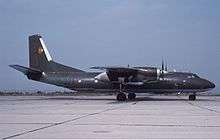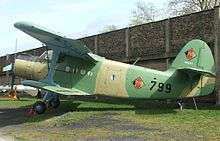Air Forces of the National People's Army
| Air Forces of the National People's Army Luftstreitkräfte der Nationalen Volksarmee | |
|---|---|
.svg.png) Logo of the East German Air Force | |
| Active | 1 March 1956 - 2 October 1990 |
| Country |
|
| Role | Air force |
| Size | 45,000 personnel, 800 combat aircraft (1989) |
The Air Forces of the National People's Army (German: Luftstreitkräfte der Nationalen Volksarmee – LSK) was the Air Force of East Germany. As with the Landstreitkräfte, the Volksmarine, and the Border troops, it was a military branch of the National People's Army (NPA).
The name Luftstreitkräfte applied originally to the air corps of the German Empire between 1910 and the end of World War I in 1918. However, the West German air force adopted the name "Luftwaffe" as used by the Third Reich air force from 1935 to the end of World War II.
At the end of November 1953, a reorganisation of air units saw air units transferred from the Ministry of the Interior directly to the Deputy Minister and Chief of the People's Police. The air regiments were reorganized into the Aero Club 1 (Cottbus), 2 (Drewitz) and 3 (Bautzen), which in turn were divided into two sections. Starting in 1954, additional Z-126 and M-1D from Czechoslovakian production were made available.[1]
On 1 March 1956 the air force was officially established as part of the National People's Army, following the GDR's entry into the Warsaw Pact alliance. Initially the air force (LSK), with its headquarters at Cottbus, was separate from the Luftverteidigung (Air Defence, headquartered at Strausberg (Eggersdorf). It was intended to establish three fighter divisions, an attack aircraft division and an anti-aircraft division. However, eventually only the 1st and 3rd Aviation Divisions and the 1st Flak-Division were created.[2] On 1 June 1957 there was a merger of the two administrations in Strausberg (Eggersdorf), and the new headquarters was renamed the Kommando LSK/LV.
Organization
Kommando Luftstreitkraefte/Luftverteidigung (Kdo LSK/LV)
A decisive number of military units and formations have been under direct control of the Kommando LSK/LV, the Air Force Staff and the Air Force Command of the NPA, with its HQ in Strausberg.
1st Luftverteidigungsdivision (1st LVD)

The 1st LVD (en: 1st Air Defence Division), with its HQ in Cottbus, was in charge to provide air defence throughout the southern territory of the GDR. The following units were subordinated to that particular division:
- Jagdfliegergeschwader 1 (JG-1) (en: 1st Fighter Wing) „Fritz Schmenkel“, Holzdorf Air Base
- Fliegertechnisches Bataillon 1 (FTB-1) „Willi Budich“, Holzdorf (Jessen)
- Nachrichten- und Flugsicherungsbataillon 1 (NFB-1), Holzdorf
- Jagdfliegergeschwader 3 (JG-3) „Wladimir Komarow“, Preschen
- Fliegertechnisches Bataillon 3 (FTB-3) „Walter Stoecker“, Preschen[3]
- Nachrichten- und Flugsicherungsbataillon 3 (NFB-3), Preschen
- Jagdfliegergeschwader 7 (JG-7) „Wilhelm Pieck“, Drewitz (disbanded in 1989)
- Nachrichten- und Flugsicherungsbataillon 7 (NFB-7), Drewitz
- Jagdfliegergeschwader 8 (JG-8) „Hermann Matern“, Marxwalde
- Fliegertechnisches Bataillon 8 (FTB-8), Marxwalde
- Nachrichten- und Flugsicherungsbataillon 8 (NFB-8), Marxwalde
- 41. Fla-Raketenbrigade (41. FRBr) „Hermann Dunker“, Ladeburg
- Fla-Raketenabteilungsgruppe 411 (FRAG-411), Badingen
- Fla-Raketenabteilung 4121 (FRA-4121), Fürstenwalde
- Fla-Raketenabteilung 4122 (FRA-4122), Prötzel
- Fla-Raketenabteilung 4123 (FRA-4123), Klosterfelde
- Fla-Raketenabteilung 4124 (FRA-4124), Beetz near Kremmen
- Fla-Raketenabteilung 4131 (FRA-4131), Schönermark
- Fla-Raketenabteilung 4132 (FRA-4132), Fehrbellin
- Fla-Raketenabteilung 4133 (FRA-4133), Zachow
- Fla-Raketenabteilung 4134 (FRA-4134), Markgraf-Pieske
- Funktechnische Abteilung 4101 (FuTA-4101), Ladeburg
- Technische Abteilung 4120 (TA-4120), Ladeburg
- 51. Fla-Raketenbrigade (51. FRBr) „Werner Lamberz“, Sprötau
- Fla-Raketenabteilungsgruppe 511 (FRAG-511), Eckolstädt
- Fla-Raketenabteilung 5121 (FRA-5121), Dietersdorf
- Fla-Raketenabteilung 5122 (FRA-5122), Blankenburg
- Fla-Raketenabteilung 5123 (FRA-5123), Seebergen
- Fla-Raketenabteilung 5124 (FRA-5124), Remda
- Fla-Raketenabteilung 5125 (FRA-5125), Eckolstädt
- Technische Abteilung 5120 (TA-5120), Sprötau
- Fla-Raketenregiment 31 (FRR-31) „Jaroslaw Dombrowski“, Straßgräbchen
- Fla-Raketenabteilung 311 (FRA-311), Groß Döbern
- Fla-Raketenabteilung 312 (FRA-312), Großräschen
- Fla-Raketenabteilung 313 (FRA-313), Kroppen
- Fla-Raketenabteilung 314 (FRA-314), Großröhrsdorf
- Technische Abteilung 310 (TA-310), Straßgräbchen
- Funktechnisches Bataillon 31 (FuTB 31), Döbern
- Funktechnisches Bataillon 41 (FuTB-41) „Arvid Harnack“, Holzdorf
- Funktechnisches Bataillon 51 (FuTB-51) „Paul Schäfer“, Sprötau
- Funktechnisches Bataillon 61 (FuTB-61), Müncheberg
- Nachrichtenbataillon 31 (NB-31) „August Willich“, Cottbus
3rd Luftverteidigungsdivision (3rd LVD)
The 3rd LVD (en: 3rd Air Defence Division), with its HQ in Trollenhagen, was in charge to provide air defence throughout the northern territory of the GDR. The following units were subordinated to that particular division:
- Musikkorps der LSK/LV, Trollenhagen
- Jagdfliegergeschwader 2 (JG-2) „Juri Gagarin“, Trollenhagen
- Fliegertechnisches Bataillon 2 (FTB-2) „Herbert Baum“, Trollenhagen
- Nachrichten- und Flugsicherungsbataillon 2 (NFB-2), Trollenhagen
- Jagdfliegergeschwader 9 (JG-9) „Heinrich Rau“, Peenemünde
- Fliegertechnisches Bataillon 9 (FTB-9) „Käthe Niederkirchner“, Peenemünde
- Nachrichten- und Flugsicherungsbataillon 9 (NFB-9), Peenemünde
- Zieldarstellungskette 33 (ZDK-33), Peenemünde
- 43. Fla-Raketenbrigade (43. FRBr) „Erich Weinert“, Sanitz
- Fla-Raketenabteilungsgruppe 431 (FRAG-431), Cammin/Prangendorf
- Fla-Raketenabteilung 4321 (FRA-4321), Abtshagen
- Fla-Raketenabteilung 4322 (FRA-4322), Barth
- Fla-Raketenabteilung 4323 (FRA-4323), Hinrichshagen
- Fla-Raketenabteilung 4324 (FRA-4324), Neuenkirchen
- Fla-Raketenabteilung 4331 (FRA-4331), Barhöft
- Fla-Raketenabteilung 4332 (FRA-4332), Nienhagen
- Fla-Raketenabteilung 4333 (FRA-4333), Bastorf
- Fla-Raketenabteilung 4334 (FRA-4334), Kirchdorf
- Fla-Raketenabteilung 4335 (FRA-4335), Dranske
- Fla-Raketenabteilung 4351 (FRA-4351), Retschow
- Funktechnische Abteilung 4301 (FuTA-4301), Rövershagen
- Technische Abteilung 4320 (TA-4320), Sanitz
- Fla-Raketenregiment 13 (FRR-13) „Etkar André“, Parchim
- Fla-Raketenabteilung 131 (FRA-131), Warin
- Fla-Raketenabteilung 132 (FRA-132), Tramm
- Fla-Raketenabteilung 133 (FRA-133), Ziegendorf
- Fla-Raketenabteilung 134 (FRA-134), Steffenshagen
- Technische Abteilung 130 (TA-130), Parchim
- Fla-Raketenregiment 23 (FRR-23) „Rudolf Breitscheid“, Stallberg
- Fla-Raketenabteilung 231 (FRA-231), Altwarp
- Fla-Raketenabteilung 232 (FRA-232), Eichhof
- Fla-Raketenabteilung 233 (FRA-233), Burg-Stargard
- Fla-Raketenabteilung 234 (FRA-234), Weggun
- Funktechnisches Bataillon 23 (FuTB-23) „Liselotte Herrmann“, Pragsdorf
- Funktechnisches Bataillon 33 (FuTB-33) „Fritz Behn“, Pudagla
- Funktechnisches Bataillon 43 (FuTB-43), Parchim
- Nachrichtenbataillon 33 (NB-33) „Max Christiansen-Clausen“, Trollenhagen
FO FMTFK
All fighter-bomber aircraft, transport aircraft, reconnaissance aircraft and transport helicopters were under the control of the FO FMTFK (roughly translates into: "Lead unit of the Frontal and Military air units", Führungsorgan der Front- und Militärtransportfliegerkräfte). The following units were part of the FO FMTFK:
- Jagdbombenfliegergeschwader 37 (JBG-37) „Klement Gottwald“, Drewitz
- Fliegertechnisches Bataillon 37 (FTB-37), Drewitz
- Nachrichten- und Flugsicherungsbataillon 37 (NFB-37), Drewitz
- Jagdbombenfliegergeschwader 77 (JBG-77) „Gebhardt Leberecht von Blücher“, Laage
- Fliegertechnisches Bataillon 77 (FTB-77), Laage
- Nachrichten- und Flugsicherungsbataillon 77 (NFB-77), Laage
- Marinefliegergeschwader 28 (MFG-28) „Paul Wieczorek“, Laage
- Fliegertechnisches Bataillon 28 (FTB-28), Laage
- Nachrichten- und Flugsicherungsbataillon 28 (NFB-28), Laage
- Transporthubschraubergeschwader 34 (THG-34) „Werner Seelenbinder“, Brandenburg-Briest
- Fliegertechnisches Bataillon 34 (FTB-34), Brandenburg-Briest
- Verbindungsfliegerstaffel 14 (VS-14), Strausberg
- Fliegertechnisches Bataillon 14 (FTB-14), Strausberg
- Transportfliegerstaffel 24 (TFS-24), Dresden-Klotzsche
- Fliegertechnisches Bataillon 24 (FTB-24), Dresden-Klotzsche
- Taktische Aufklärungsfliegerstaffel 47 (TAFS-47), Preschen
- Taktische Aufklärungsfliegerstaffel 87 (TAFS-87), Drewitz
Insignia
A diamond-shaped symbol identified LSK aircraft – divided into vertical black, red and gold stripes corresponding to the horizontal fesses or bars on the GDR state flag. The centre of the diamond portrayed the GDR coat of arms: a hammer and compass surrounded by a wreath of yellow grain. The symbol differentiated the Luftstreitkräfte from the West German Luftwaffe, which displays a stylised Iron Cross similar to the emblem on German aircraft during World War I.
Uniforms
The uniforms of the two German air forces were also different: following an older German tradition, LSK/LV uniforms were the same stone gray worn by army personnel, modified by distinctive blue insignia (similar in style, but not colour, to World War II Luftwaffe ranks) and piping. West German uniforms, on the other hand, were blue with yellow insignia and more closely modelled on those worn by Luftwaffe personnel during World War II.
Aircraft
Starting in 1953, East Germany received An-2, La-9, Yak-11, and Yak-18 aircraft and the MiG-15 in 1956 which were provided by the Soviet Union. The first MiG-21s were delivered in 1962. The 1970s saw the introduction of the MiG-23, while Su-22 fighter-bombers were delivered in the 1980s. The latest addition was the MiG-29 in 1988. The inventory also included Soviet-built helicopters along with trainers and other light aircraft manufactured in Czechoslovakia.
The East German Air Force was unique among Warsaw Pact countries in that it was often equipped with the most advanced Soviet fighters, instead of downgraded export models. As an extension of the Soviet 16th Air Army deployed in East Germany, the Luftstreitkräfte was expected to play a front-line role in any war with NATO. As a result, it was under closer Soviet control than the air forces of other Warsaw Pact states.
After German reunification in 1990, the Luftwaffe assumed control over Luftstreitkräfte equipment and enlisted some of its personnel. Many of the GDR's military aircraft were obsolete or incompatible with NATO technical standards, and were sold to other countries. However, the Luftwaffe did retain the MiG-29 in both air defense and aggressor roles because of its excellent capabilities.
LSK/LV equipment in 1989



Equipment of the LSK/LV in 1989:
| category | equipment | country of origin | number | use by the Luftwaffe |
notes |
|---|---|---|---|---|---|
| fighter aircraft/trainers | MiG-21 | |
251 | ||
| MiG-29 | |
24 | until 2004 | 22 passed on to Poland[4] | |
| MiG-23 | |
47 | |||
| MiG-23BN | |
18 | |||
| Su-22 | |
54 | |||
| L-39 | |
52 | |||
| transport aircraft | An-2 | |
18 | ||
| An-26 | |
12 | until 1994 | ||
| Il-62 | |
3 | until 1993 | ||
| Tu-134 | |
3 | until 1992 | ||
| Tu-154 | |
2 | until 1997 | ||
| L-410 | |
12 | until 2000 | ||
| Z-43 | |
12 | |||
| helicopters | Mi-2 | |
25 | ||
| Mi-8 | |
98 | until 1997 | ||
| Mi-24 | |
51 | until 1993 | ||
| Mi-14 | |
14 | |||
| surface-to-air missiles | S-75 Dvina | |
48 | SA-2 Guideline | |
| S-75 Wolchow | |
174 | SA-2 Guideline | ||
| S-125 Newa | |
40 | SA-3 Goa | ||
| S-200 Wega | |
24 | SA-5 Gammon | ||
| S-300 | |
12 | SA-10 Grumble; were returned to the Soviet Union before the Reunification of Germany |
References
- ↑ "Administration of the Aero Club (Federal Archive)
- ↑ Heinrich Engelhardt:NVA Luftstreitkräfte/Luftverteidigung In: Klaus Naumann:NVA: expectations and reality,according to selected documents mediator, Berlin / Bonn /... Herford, 1993, ISBN 3-8132-0430-8.
- ↑ The airfield Preschen is a former NVA military airfield. It is located in the town of Neisse Malxetal in southern Brandenburg , between the hamlets Jocksdorf , Preschen and the large community Schackendorf. The airfield was built in 1953/54 and gradually expanded until 1990. Auf dem Flugplatz waren verschiedene fliegenden Kampfverbände der 1. On the airfield were stationed several combat units of the 1. LVD, mainly JG-3, and since 1974 the Taktische Aufklärungsfliegerstaffel 47 (TAFS-47)(Tactical reconnaissance squadron 47).From 1999 to 2003 there was a techno club, Club K, located in an aircraft hangar on the base. Today the place is run by the company POINT 36, which offers various meeting facilities there. The airport has a 2500 Dash-meter and 80 meter wide airstrip (SLB).
- ↑ Sold for one symbolic Euro: Bernd Lemke, Dieter Krüger, Heinz Rebhan, Wolfgang Schmidt: Die Luftwaffe 1950 bis 1970. Konzeption, Aufbau, Integration. Oldenbourg Wissenschaftsverlag, Munich 2006, ISBN 3-486-57973-8, p. 833.)
External links
| Wikimedia Commons has media related to Air force of the German Democratic Republic. |